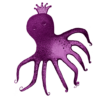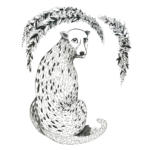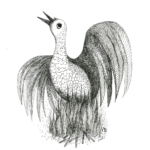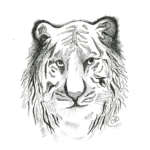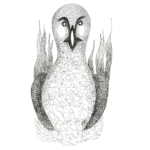All cultures develop Animal Wisdom:
Stories and proverbs bear witness to how a culture regards its animals, as bearers of vices and virtues… like the proverbial obstinacy of the donkey.
These narratives teach the very qualities society’s would like to see developed in their citizens, like courage, patience, generosity and kindness.
The QfWf-storytelling program collects animal stories and proverbs ― as a Golden Ratio of Animal Wisdom from different cultures ― and develops these into educational materials, like e-books. The aim is to contribute to the art of living as an inclusive society by highlighting the (inter)cultural backgrounds of fables and transcultural aspects of storytelling traditions.

The way in which stories, proverbs and art express animal wisdom reveals both transcultural similarities as well as cultural diversity. Fables represent therefore a unique mirror to explore intercultural differences.
Animal pranks and the art of living
Cleverness is taught by the fox in the European stories ‘Van den vos Reynaerde’ , whereas this quality belongs to the spider Anansi in the Ghanaian and Caribbean storytelling traditions:
As Clever as a Fox.
Nobody tells stories to Ntikuma, the spider child [Ghanaian proverb].

Fox in European stories and Spider in Ghanaian and Caribbean narratives embody cleverness. Such cultural differences provide fascinating perspectives for learning from each other’s cultures.
Another example: the Unicorn is a mythological animal in diverse cultures. However, the Eastern and Western depictions of this fable animal show a distinctive difference.
The European Unicorn has a longer spiral horn and often buck’s legs and a buck’s goatee, while the Eastern images show a shorter horn with no spiral. The Chinese Unicorn looks like a combination of deer and horse.
Cultural Diversity
Whereas in European visions and Western sayings the pig has been associated with debauchery and laziness, and is considered an impure animal in Islamic culture, the Chinese culture regards this animal as a paragon of ‘joie de vivre’ and loyalty: as characterized in the Chinese zodiac.
How do we talk about such differences without qualifying cultures as being either ‘higher’ and ‘lower’—‘more primitive’ or ‘more civilized’? Is there an appreciative way to compare cultures in the way they narratively link aspects of wisdom and (im)moral behavior to animals through stories, images, and proverbs? So that thereby we might develop an intercultural language and layered view to appreciate cultural differences!
The Natural Wisdom
Historically, cultures express their fundamental dependence on the natural elements and the fruits of Mother Earth. For example, as an animal associated with the earth, the snake in mythical stories from many cultures is connected with fertility, vitalization and (spiritual) creation processes.

However, by a dogmatic interpretation of the Christian genesis story, the snake is associated with the devil, whereas hermetic and gnostic visions see the snake as symbol both of natural wisdom and unity (the Ouroboros) as well as the loss of an original goodness. Here, the religious portrayal of Paradise or Arcadia pays tribute to a Golden Era in which humans lived in harmony with animals and gods.
In fairy tales, legends and myths from all corners of the world, we read how ‘the good life’ springs from the water of life and how the tree of life brings the human world in accordance with other creatures; through the mystery of the interdependence of the micro — macro cosmic order.
The fact that we breathe the same air and receive the same light, warmth and energy from the same sun, points to the common ground that humans, animals, trees and other living beings are reciprocally dependant and in that sense equal to one and other!
This fundamental fact of life makes the symbolism of the natural elements eminently suitable for comparing cultural differences in the depicting of different Animal Wisdoms in elementary and appreciative ways.
Therefore, the Wheel of Intercultural Art of Living has been developed by the QfWf, with all of the rich cultural symbolism of the natural elements:
The Symbolism of the Natural Elements and of the Quintessence
The four quadrants of the Wheel of Animal Wisdom — with the natural elements of earth, water, air, fire — border in the centre on a small circle, the fifth element of ether or quintessence. This wheel forms a suitable entrance to arrange the animal stories and animal wisdom on the basis of the elements with which the animals are connected:
- Green – Earth – Snake as a representative of earth animals
- Blue – Water – Bone representing fish / aquatic animals
- Yellow – Air – Raven representing Birds / air animals
- Red – Fire – Leopard representing Felines
- White/Purple – Ether – Firebird as representative of Feline Animals
The four cardinal directions
The four animals on the outside point to the four cardinal directions and are taken from Chinese mythology:
- Black Warrior of the North (turtle with snake),
- Azure Dragon of the East,
- Vermilion Firebird of the South,
- White Tiger of the West
while the
- Yellow Dragon is the ruler of the Center
These five cosmic animals (Sì Shòu 四 — celestial emblems) guard both the four cardinal directions and the centre. Each animal is associated with a season, wind, color, element, virtue and other relevant attributes. A characteristic of Chinese cosmology is that in addition to the four cardinal directions there is a fifth direction of ‘the middle’. In the Wheel of Animal Wisdom the centre corresponds to the fifth element, ether, the element relating to transformation.
The QfWf-Wheel of Animal Wisdom
The QfWf-Wheel is based on the reciprocal nature of life forms and the symbolism of the natural elements. These elements are politically and socially neutral and are therefore appropriate when discussing the differences in cultural expressions of animal wisdom in an elementary and non-judgmental way.
The elemental arrangement of the Wheel of Animal Wisdom appeals directly to the imagination and prevents cultural over- or under-ranking when comparing the various animal stories and other cultural expressions of animal wisdom — such as those found in visual arts, rituals, meditation, philosophy, music, and dance.
For the purpose of intercultural comparisons, the Wheel of the Intercultural Art of Living, was developed by the QfWf, based on the symbolism of the natural elements. As the starting point for understanding both cultural diversity as well as transcultural wisdom of fables this has been developed into the Wheel of Animal Wisdom:
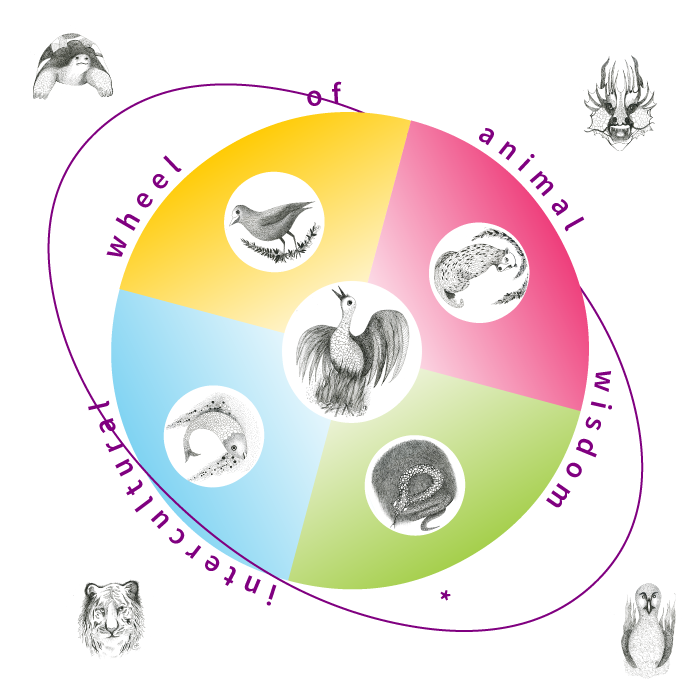
Transcultural Symbolism on ‘the good life’
“How to live life well” opens the quest for developing the art of living. Answers are given by means of fables and other narratives, philosophical reflections and artistic expressions of natural beauty and praxis to enhance wisdom about ‘the good life’.

Various kinds of practical wisdom are inspired by nature and the elements and have been developed by all cultures. For example, the Golden Ratio is visible in the way the snail shell is organically formed. The purple snail contains a purple dye that represents royalty and was traditionally used in creating the state robes of monarchs.
Cultural expressions of the art of living are very diverse, yet they circle around a common theme based on ‘the good life’! This universal focus for the art of living worldwide includes different interpretations and praxis both for individual growth ― “becoming who you are” ― as well as ancient wisdom about how to create a harmonious community and how to guard the humanization of (post)modern society.
The good life, as seen from the perspective of the intercultural art of living, concerns people as well as the wider circles of living beings on earth, nature (spirits) and our ancestors.
Thus, the Unicorn is a mythological creature and at the same time an important symbol of strength and courage for developing the art of organizing life in the community. The pointed horn in the middle of the forehead of European Unicorns has a spiral groove which symbolizes bravery.
The community — viewed from a ‘pre-modern’ worldview from which many of the animal stories stem — extends into ever-widening circles with spirits, goddesses and gods. Ultimately and profoundly, the ‘circle of life’ encompasses the reciprocity and harmony of living together with all beings in nature and the cosmos. The rhythms of the eternal natural cycles and cosmic laws form an elementary basis for the cosmopolis, including the (moral) beauty of living harmoniously together.
Objectives of the Animal Wisdom Program
With the elemental ranking by the Intercultural Wheel of Animal Wisdom, cultural over- and under-ranking is avoided, while still allowing for the comparison of different animal stories and various cultural expressions of animal wisdom.
